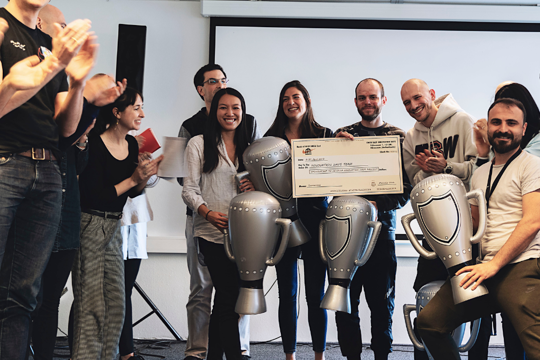
Embracing diversity in 'thinking styles' to drive team performance
In this article, you'll learn to avoid the common trap of homogeneous thinking and instead create a balanced team that leverages the strengths of four distinct cognitive roles.
You’ll learn:
-
The four cognitive roles that drive innovation and high performance in teams.
-
Why balancing these roles leads to better problem-solving and execution.
-
How to identify and nurture these roles within your team to drive success.
Different thinking styles drive stronger decisions.
Every leader understands the importance of innovation and problem-solving in driving business success. But it’s not just about having smart, capable people on your team—it’s about having the right balance of thinking styles. Too often, teams struggle because they lack cognitive diversity—the diversity of thought, problem-solving approaches, and decision-making styles that can unlock breakthroughs and drive results.
The problem arises when teams are composed of individuals with similar thinking styles. For example, a team full of creative idea generators may have lots of exciting concepts but struggle to execute. On the other hand, a team dominated by implementers might be great at getting things done but lack innovative solutions to the challenges they face.
Procter & Gamble (P&G), one of the world’s largest and most innovative companies, conducted research into what makes innovation teams high-performing. They discovered that the best teams consist of individuals who each play one of four specific cognitive roles: Generator, Conceptualizer, Optimizer, and Implementer. These roles complement one another and ensure that teams don’t get stuck in any single phase of problem-solving or execution.
By understanding these roles and ensuring your team has a healthy balance of each, you can unlock more effective innovation, decision-making, and project execution.
The Four Cognitive Roles that Drive Team Success
According to P&G’s research, there are four cognitive roles that every high-performing innovation team needs. Here’s a breakdown of each role and how it contributes to team success:
1. The Generator
Generators are the individuals who love seeing new opportunities and starting new initiatives. They thrive on creativity, and their primary contribution is their ability to generate a wide range of ideas, questions, and possibilities. Generators bring energy and enthusiasm to a team, and they often help identify new problems that need solving.
However, generators are often less interested in the execution or practicalities of how to bring ideas to life. They excel at the early stages of innovation but may struggle with follow-through or narrowing down options.
- Strength: Creativity, idea generation, identifying opportunities.
- Potential Challenge: May struggle with focus or execution, leaving ideas unfinished.
2. The Conceptualizer
Conceptualizers excel at taking the raw ideas generated by the team and imagining how they might work in the real world. They enjoy brainstorming, but their real strength is in turning broad ideas into potential strategies, solutions, or models. Conceptualizers thrive on analysis and exploring different angles of a problem.
While they’re great at expanding on ideas and developing options, conceptualizers may sometimes overthink or delay action. They can get caught up in the “what ifs” and need others to push them toward decision-making and implementation.
- Strength: Strategic thinking, turning ideas into models or concepts.
- Potential Challenge: May struggle with moving from ideas to action and decision-making.
3. The Optimizer
Once a set of options or strategies has been developed, the Optimizer steps in to assess the practicality and efficiency of each one. Optimizers are analytical and detail-oriented; they focus on refining ideas and finding the best path forward. Their strength lies in improving processes, optimizing resources, and ensuring that the team’s ideas are grounded in reality.
Optimizers may sometimes be perceived as overly critical because they tend to focus on what could go wrong or how to improve ideas, but their role is crucial in ensuring that the team chooses the best possible approach.
- Strength: Refining ideas, optimizing resources, ensuring efficiency and practicality.
- Potential Challenge: Can come across as overly critical or risk-averse, which may stifle creativity if not managed well.
4. The Implementer
Implementers are action-oriented individuals who get things done. Once a solution has been refined and chosen, the implementer takes the lead in executing the plan. They thrive on organization, planning, and completion, making sure that projects move forward and reach the finish line.
However, implementers may sometimes prioritize action over reflection, which can lead to rushing decisions without thoroughly considering all options. They may also become frustrated if the team spends too much time in the idea or conceptualization stages.
- Strength: Execution, planning, and making things happen.
- Potential Challenge: May push for action too quickly without considering alternatives or strategic adjustments.
Why Cognitive Diversity Matters
Cognitive diversity is crucial because each of these roles fills a unique and necessary gap in the problem-solving and innovation process. A team composed entirely of generators might have plenty of ideas but no clear direction or execution. Similarly, a team full of implementers might get things done quickly but miss out on innovative solutions that could improve outcomes.
By ensuring your team has a balance of all four roles, you create a system where ideas can flow freely, be thoughtfully refined, and ultimately executed with precision. This balance helps teams avoid common pitfalls like groupthink, stalled projects, or inefficient execution.
Example: How Cognitive Diversity Solves Real Problems
Imagine a company that’s trying to launch a new product. If the team is dominated by generators, they might come up with countless exciting ideas for features, but without optimizers or implementers, those ideas could stay in the brainstorming phase indefinitely.
Alternatively, if the team is mostly implementers, they might rush to market with a product that’s not fully developed, missing out on key customer insights or innovations that would make it more successful.
However, if the team has a generator to spark creativity, a conceptualizer to build models and strategies, an optimizer to refine the best ideas, and an implementer to ensure flawless execution, they can work together to develop and launch a product that’s both innovative and practical.
How to Identify and Leverage the Four Roles in Your Team
Building a cognitively diverse team means identifying the strengths of your team members and understanding which cognitive roles they naturally lean toward. Here are some steps to help you do that:
1. Assess Your Team’s Strengths
Take time to assess the natural strengths and preferences of your team members. This can be done through self-assessment tools, personality tests, or simply observing how individuals approach problem-solving.
-
Generators: Look for team members who are highly creative, enjoy brainstorming, and tend to think outside the box.
-
Conceptualizers: These individuals are strategic thinkers who enjoy developing ideas and exploring possibilities.
-
Optimizers: Optimizers will often focus on refining processes and finding the most efficient way to accomplish tasks.
-
Implementers: Implementers are action-oriented individuals who prioritize getting things done and moving projects forward.
2. Ensure a Balance of Roles
Once you’ve identified the cognitive roles in your team, assess whether you have a good balance. If your team leans too heavily in one direction, consider bringing in new team members with complementary skills or encouraging existing team members to develop new abilities.
For example, if your team lacks optimizers, you may find that ideas are abundant, but processes are inefficient. By adding an optimizer to the mix, you can ensure that the best ideas are refined and executed in a practical way.
3. Encourage Collaboration Across Roles
Cognitive diversity only works if team members are willing to collaborate and respect one another’s contributions. Encourage your team to embrace their different roles and recognize the value that each brings to the table.
For instance, generators and implementers may have different approaches, but both are essential for success. Generators should appreciate the implementer’s ability to bring ideas to life, while implementers should value the generator’s creative thinking that sets the stage for innovation.
How you can start implementing these ideas
Here are some practical tips and reflective questions to help you leverage cognitive diversity in your team:
1. Identify Gaps in Cognitive Diversity:
-
Advice: Take a close look at your team’s composition and identify any gaps in the four cognitive roles. If certain roles are missing, consider how you can bring more balance to the team.
-
Thought Starter: Which cognitive roles are overrepresented or underrepresented in my team, and how might this be affecting our performance?
2. Embrace Each Role’s Contribution:
-
Advice: Help your team understand the value of each cognitive role and encourage collaboration across different thinking styles.
-
Thought Starter: How can I foster respect and collaboration between team members who approach problem-solving in different ways?
3. Provide Opportunities for Each Role to Shine:
-
Advice: Make sure that each cognitive role has a chance to contribute during different phases of a project. Whether it’s brainstorming, refining, or executing, all roles should be actively involved.
-
Thought Starter: How can I ensure that each phase of our projects allows for contributions from generators, conceptualizers, optimizers, and implementers?
Wrap-up: Take stock of the problem-solving styles in your team to better harness strengths, and address gaps.
Cognitive diversity is one of the most powerful tools a leader can use to build a high-performing team. By ensuring that your team includes the roles of Generator, Conceptualizer, Optimizer, and Implementer, you’ll have the right balance of creativity, strategy, refinement, and execution to drive innovation and deliver results.
Remember, it’s not about having a team full of like-minded thinkers—it’s about embracing different cognitive styles and working together to solve problems, innovate, and execute with excellence.
CHANGE BY SPRINT VALLEY
Ready for change?
Fast-track ambitious ideas and build a future-ready business your people are proud to be a part of.
